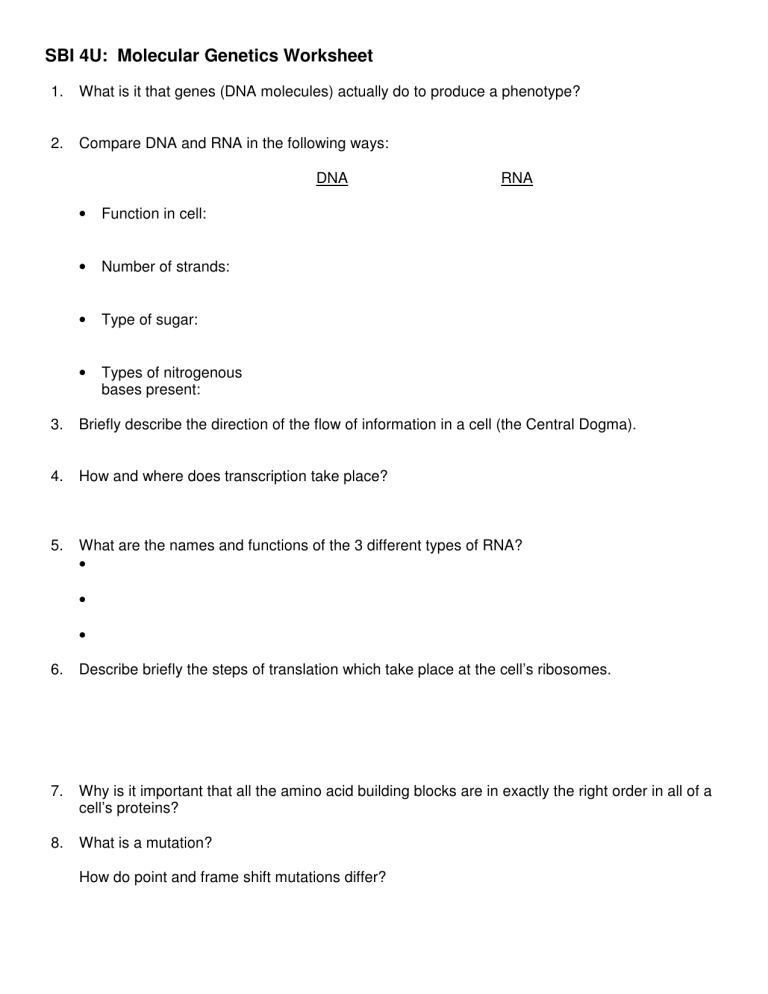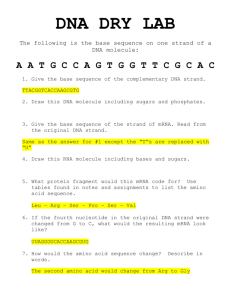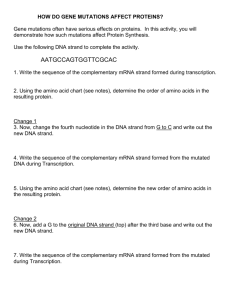SBI 4U: Molecular Genetics Worksheet

SBI 4U: Molecular Genetics Worksheet
1. What is it that genes (DNA molecules) actually do to produce a phenotype?
2. Compare DNA and RNA in the following ways:
DNA RNA
•
Function in cell:
•
Number of strands:
•
Type of sugar:
•
Types of nitrogenous
bases present:
3. Briefly describe the direction of the flow of information in a cell (the Central Dogma).
4. How and where does transcription take place?
5. What are the names and functions of the 3 different types of RNA?
•
•
•
6. Describe briefly the steps of translation which take place at the cell’s ribosomes.
7. Why is it important that all the amino acid building blocks are in exactly the right order in all of a cell’s proteins?
8. What is a mutation?
How do point and frame shift mutations differ?
9. Two strands of a DNA molecule are shown below. The bottom strand is the coding (sense) strand.
5’-TTATGGTCATTGATTGTGGG-3’
3’-AATACCAGTAACTAACACCC-5’ a) Transcribe the bottom coding strand of DNA into mRNA. b) What is the amino acid sequence of the protein coded for by this messenger RNA? (Hint:
Look for a start codon and be sure to use your genetic code.) c) Draw the transfer RNA that is complimentary to the third codon of the messenger RNA.
Include the amino acid it would contain. d) A substitution mutation occurs in the coding sequence of the DNA in which the 8 th nucleotide (G) is replaced with an ‘A.’ How does this change the amino acid sequence?
Diagram the protein below.
How serious do you think this mutation is? Why? e) A mutation occurs in the coding sequence of DNA in which the 6 th
nucleotide (a C) is deleted. How does this change the amino acid sequence? Diagram the protein below. How serious do you think this mutation is? Why? f) How have mutations been important to the history of life on earth – or – what would life on earth be like if there were no mutations?
11.
PROTEIN SYNTHESIS MUTATION WORKSHEET
Gene:
T
C
A
T
T
Normal mRNA: Normal Protein:
C
T
A
A
G
C
T
T
T
T
C
A
T
Template strand
Fill-in complementary strand
Construct mRNA Construct protein
Note: The initiator (start) is at the bottom of template strand. Synthesize mRNA and read code from bottom going up.
Mutation 1: Change the 6 th
nucleotide in the original template strand from T to C. (Count from the bottom where the promoter is)
New protein structure:
Type of mutation:
Will cell likely be affected?:
Mutation 2: Change the 7 th
nucleotide in the original template from T to G.
New protein structure:
Type of mutation:
Will cell likely be affected?:
Mutation 3: Change the 11 th
nucleotide in the original template from A to T.
New protein structure:
Type of mutation:
Will cell likely be affected?:
Mutation 4: Delete the 4 th
nucleotide from the original template strand.
New protein structure:
Type of mutation:
Will cell likely be affected?:








